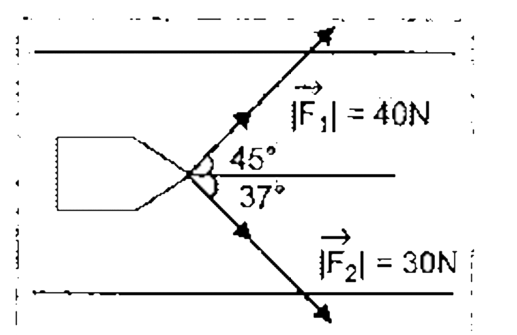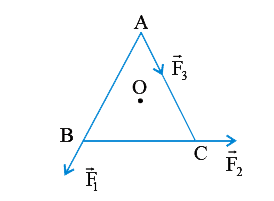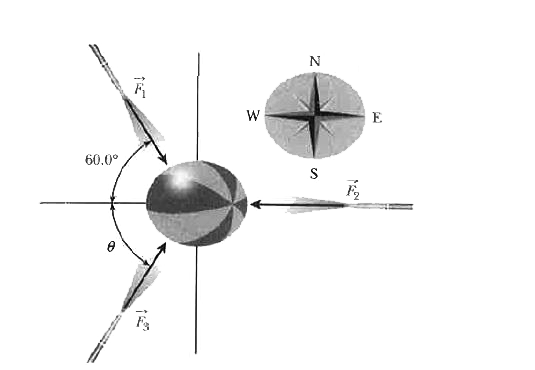Compare the components of vector equation →F1+→F2+→F3=→F4
We can resolve all the vectors in x, y and z components with respect to Cartesian coordinate system.
Once we resolve the components we can separately equate the x components on both sides, y components on both sides, and z components on both the sides of the equation, we then get
F1x+F2x+F3x=F4x
F1y+F2y+F3y=F4y
F1z+F2z+F3z=F4z
Topper's Solved these Questions
- KINEMATICSBOOK - NCERT TAMILCHAPTER - KINEMATICSEXERCISE - EXERCISE (I. Multi Choice Question)
15 Videos
- KINEMATICSBOOK - NCERT TAMILCHAPTER - KINEMATICSEXERCISE - EXERCISE (IV. Exercises )
20 Videos
- HEAT AND THERMODYNAMICSBOOK - NCERT TAMILCHAPTER - HEAT AND THERMODYNAMICSEXERCISE - EVALUATION (Numerical Problems)
13 Videos
- KINETIC THEORYBOOK - NCERT TAMILCHAPTER - KINETIC THEORYEXERCISE - ADDITIONAL EXERCISE
4 Videos
Similar Questions

A boat is tied to river bank with ropes as shown in figure. Force exterted by ropes on boat is shown in figure. What are x and y-components of →F1 and →F2 vectors?
View SolutionABC is an equilateral with O as its centre →F1,→F2 and →F3 represent three forces acting along the sides AB, BC and AC respectively. If the total torque about O is zero then the magnitude of →F3 is :

View Solution
Knowledge Check
At a picnic, there is a contest in which hoses are used to shoot water at a beach ball from three directions. As a result, three forces act on the ball, →F1,→F2and→F3 (see the drawing). The magnitudes of →F1and→F2=50.0NandF2=90.0N. Using the graphical technique, determine the angle such that the resultant force acting on the ball is zero.
 A21∘B26∘C34∘D39∘
A21∘B26∘C34∘D39∘A body is under the action of three forces →F1,→F2and→F3. In which case the body cannot undergo angular acceleration ?
A−→F1,−→F2and−→F3 are concurrentB−→F1+−→F2+−→F3=0C−→F1,−→F2 is parallel to −→F3 but the three forces are not concurrentD−→F1and−→F2 act at the same point but −→F3 acts at different point.A body is under the action of three forces →F1,→F2 and →F3. In which case the body cannot undergo angular acceleration ? .
A→F1,→F2 and →F3 are concurrent, point of concurrence beign centre of mass .B→F1+→F2+→F3=0C→F1,→F2 is parallel to →F3 but the three forces are not concurrent .D→F1 and →F2 act at the same point but →F3 acts at different point .
A vector →F1 is along the positive X-axis. If its vectors product with another vector →F2 is zero then →F2 could be
View SolutionA vector →F1 is along the positive X-axis. If its vectors product with another vector →F2 is zero then →F2 could be
View SolutionThe figure shows an overhead view of a meter stick that can pivot about the point indicated, which is to the left of the stick's midpoint. Two horizontal forces, →F1and→F2, are applied to the stick. Only →F1 is shown. Force →F2 is perpendicular to the stick and is applied at the right end. If the stick is not to turn, (a) what should be the direction of →F2, and (b) should F2 be greater than, less than, or equal to F1?

View SolutionWhich of the four arrangements in the figure correctly shows the vector addition of two forces →F1 and →F2 to yield the third force →F3
View SolutionConsider the following four force vectors:
→F1=50.0N, due east, →F2=10.0N, due east,
→F3=40.0N, due west,→F4=30.0N, due west
Which two vectors add together to give a resultant with smallest magnitude ? In the option below, the two vectors are given followed by a magnitude and direction.
View Solution
